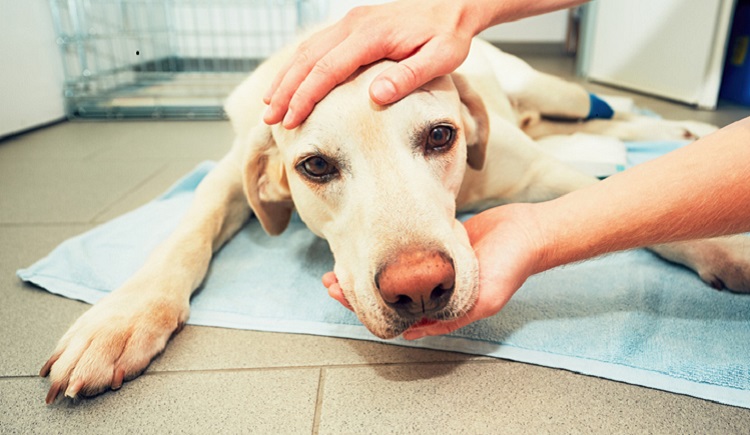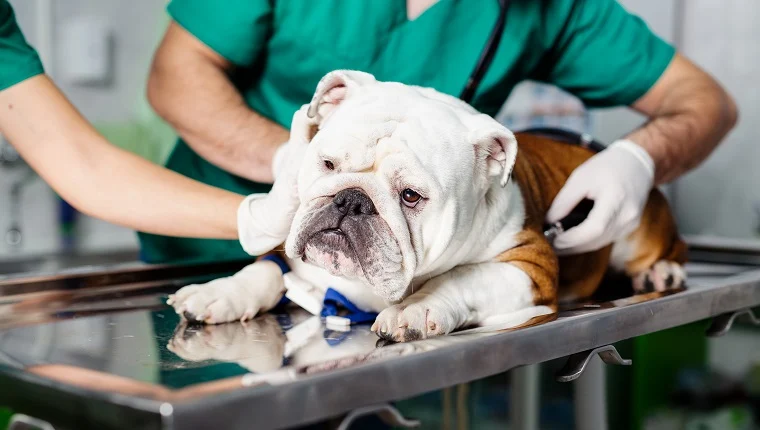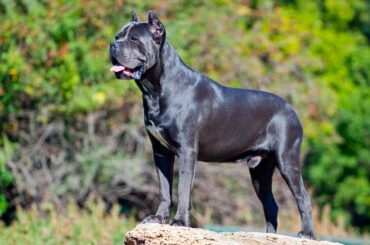Canine cancer – Cancer affects canines in the same way it affects people. The uncontrolled development of cells in the body causes cancer. These cells might come from any part of the body. Cancer can spread and infect different tissues in the body by expanding and connecting with the circulatory and lymphatic systems.
Canine cancer is the most common cause of death in dogs aged 10 and over. Half of all cancers in dogs, on the other hand, can be treated if detected early. Tumors form when a cell multiplies uncontrollably rather than following the usual cycle that leads to cell death. Tumors are divided into two types: benign and malignant.

Table of Contents
Causes of Canine Cancer
Canine cancer has no recognized etiology. Certain tumor types appear to be more common in certain breeds, implying a hereditary relationship. When a senior dog comes into the hospital sick, cancer is almost always on the list of probable diagnoses.
When your dog is exposed to recognized teratogens, tumors can develop (substances that can change DNA). A tumor can be caused by any substance or procedure that has the ability to change a cell’s DNA. Environmental variables, such as UV radiation exposure, can raise your dog’s tumor risk.
Common types of canine cancer
the common types of canine cancer include
- Melanoma
- Lymphoma
- Mast cell tumor
- Osteosarcoma
- Hemangiosarcoma
- Brain cancer
- Nose and mouth tumor
- Squamous cell carcinomas
- Bladder cancer
- Malignant Histiocytosis
- Malignant mammary cancer
Melanoma
Melanoma is a type of dog cancer that affects dogs with dark skin. Melanomas develop from pigment-producing cells called melanocytes, which give the skin its color. Melanomas might show as little, dark lumps in patches of hairy skin, but they can also look as huge, flat, wrinkled masses. Malignant melanoma is an incurable illness that originates in the mouth or the distal limbs typically the toenail beds. By the time these tumors are discovered, they have often migrated to other areas of the body, making surgical removal unfeasible.
Lymphoma
Lymphoma is a malignancy that develops from lymphocytes, which are white blood cells. A dog’s immune system relies heavily on normal lymphocytes. Large, firm lymph nodes, generally located around the jaw, in front of the shoulder, or in the back of the knees, are a classic symptom of lymphoma. Lethargy or a lack of interest in food are further signs. This might make breathing and digestion difficult. This type of dog cancer is often considered curable if caught early enough. Lymphoma is more common in Standard Poodles, Golden Retrievers, and Australian Shepherds, to name a few breeds.
Mast Cell Tumors
Mast cells are immune cells that cause allergies. Mast cells can be present in many parts of the body, although they most commonly form tumors on the skin in about 20% of dogs. They can be mildly hostile or excessively aggressive. Certain canine breeds are at a higher risk of developing this tumor, suggesting that genetics may play a role. Mast cells are immune system cells that are normally seen in the body. Allergies, such as hives and bug stings, are caused by them. Beagles, Boston Terriers, Boxers, Bulldogs, Bullmastiffs, Golden Retrievers, Labrador Retrievers, Pugs, and Weimaraners are among the breeds that are prone to malignant tumors.

Osteosarcoma
Osteosarcoma is a malignant tumor that starts in the cells of the bones. Osteosarcomas are painful tumors that can cause bone fractures, limb swelling, and lameness. It primarily affects older huge or gigantic breed dogs, but dogs of any size or age can be affected. It usually affects the bones on the outside of the shoulder, wrist, and knee. Lameness in the affected limb or a swelling over the area that appears painful at the site is also a common symptom. Large dogs, such as Boxers, Golden Retrievers, German Shepherds, Great Danes, Great Pyrenees, Greyhounds, Labrador Retrievers, and Rottweilers, are commonly affected by osteosarcoma.
Hemangiosarcoma
Hemangiosarcoma: This type of dog cancer is a tumor of the endothelial cells that coat blood arteries. Although hemangiosarcoma can affect dogs of any age or breed, it is more frequent in middle-aged or elderly canines. Because this type of canine cancer develops slowly and is practically painless, clinical indications are usually not visible until the disease has progressed to the point where it is detected. These tumors are frequently discovered after they rupture, which is a medical emergency that causes internal bleeding. Golden Retrievers, German Shepherds, and Labrador Retrievers are common dog breeds that develop these tumors.
Brain cancer
Brain tumors can cause epileptic-like seizures or other serious behavioral abnormalities. The position, size, and intensity of the tumor are determined by CAT scanning and MRI. While oral chemotherapy and radiation therapy can control some incurable tumors, if the tumor is operable, surgery may be suggested.
Mouth and Nose tumor
Mouth and Nose tumor: This is a fairly prevalent type of cancer in dogs, with the mouth being more common than the nose. A lump on the gums, bleeding, odor, and difficulty eating are all symptoms. Because many swellings are cancerous, prompt and aggressive treatment is critical. Cancer can develop inside a dog’s snout as well. Symptoms of nose cancer include bleeding from the nose, trouble breathing, and face puffiness.
Bladder cancer
Bladder Cancer: This type of canine cancer affects some breeds more than others. This is a malignancy that develops slowly in dogs, and symptoms may not appear for 3 to 6 months. Symptoms such as urinary blockage and bleeding are prevalent.
Squamous cell carcinomas
Squamous Cell Carcinoma is most commonly detected in the mouth and the toenail beds. The most typical treatment is early identification and thorough surgical removal. Only about 20% of dogs acquire metastatic illness. SCC of the tonsil and tongue is a very aggressive cancer, and only around 10% of dogs survive for a year or more despite treatment.
Malignant mammary cancer
Non-spayed female dogs are more likely to develop malignant mammary tumors, but all female dogs, regardless of reproductive status, are at risk. Nearly half of these tumors are cancerous, and if cancer has not spread, total surgical removal is suggested. Poodles, English Spaniels, English Setters, and terriers are common breeds with these tumors.
Malignant Histiocytosis
Malignant Histiocytosis is a dog cancer that primarily affects larger sports breeds. Spleen, lymph nodes, lung, bone marrow, skin and subcutis, brain, and periarticular tissue of large appendicular joints are also affected. Histiocytic sarcomas can start as many lesions in a single organ and quickly spread to other organs. Labrador Retrievers, Boxers, Shar Peis, Bulldogs, American Pit Bull Terriers, Staffordshire Terriers, and Scottish Terriers are among the affected breeds.
Symptoms of canine cancer
Symptoms of canine cancer in dogs include
- Lumps and bumps under a dog’s skin
- Disturbing scents emerging from the mouth, ears, or any other area of the body
- Disturbing discharge from the eyes, mouth, ears, or rectum
- Abdominal swelling
- Weight loss that is sudden and irreversible
- Appetite changes
- Coughing or trouble breathing
- Lethargy or melancholy
- Changes in toilet habits
- Pain signs
Diagnosis of canine cancer
The best technique to diagnose a tumor is to take a sample of it. The more accurate the diagnosis, the larger the sample size. A procedure known as a fine needle aspirate can be used to collect tumor samples. A biopsy can also be used to obtain tumor samples. A biopsy can be performed either excisional or incisional.

Treatment of canine cancer
The importance of early detection and treatment in preserving your dog’s health and quality of life cannot be overstated. As a result, it’s critical to check your dog for any abnormal lumps on a regular basis and, if necessary, schedule a veterinary appointment. Canine cancer treatments for dogs are comparable to those used in humans, and include:
- Chemotherapy
- Surgery
- Radiation therapy
- Herbal therapy is all options.
- Dietary adjustments can aid in the treatment of cancer in dogs.
Canine Cancer treatment decisions for dogs are influenced by a number of factors, including:
- The dog’s age
- His general health
- The tumor’s type
- The tumor’s biological behavior
- Cancer’s stage
RECOMMENDED ARTICLES
- Canine Influenza (Dog Flu)- Causes, Symptoms And Treatment
- Bumps or Lumps on Canine Body
- Canine Distemper Disease




